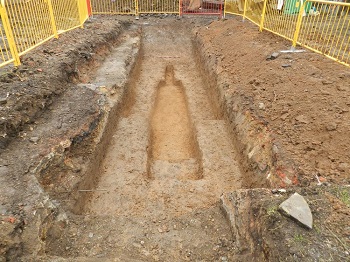Eleanor Street Shaft (Crossrail XTJ13)
Museum of London Archaeology, 2019. https://doi.org/10.5284/1055113. How to cite using this DOI
Data copyright © Crossrail Ltd, Museum of London Archaeology unless otherwise stated
This work is licensed under a Creative Commons Attribution 4.0 International License.
Primary contact
Karen
Thomas
Head of Archive
Museum of London Archaeology
Resource identifiers
- ADS Collection: 2850
- DOI:https://doi.org/10.5284/1055113
- How to cite using this DOI
Introduction

This archive presents the results of an archaeological evaluation carried out by Museum of London Archaeology (MOLA) on the site of the Eleanor Street Shaft, within the area known as the Bow Triangle, London E3, in the London Borough of Tower Hamlets. Overlying the natural terrace gravels in evaluation Trench 1 (area of the temporary shaft) was a layer of reworked brickearth, probably as a result of cultivation, dated by clay tobacco pipe to 1700-1770. Above this was a buried soil which was interpreted as a horticultural horizon. Overlying this were 19th-century building remains, sealed by modern overburden.
Underlying the modern made ground on the site was a layer covering the entire shaft area. This has been dated to c.1480-1800/1900 and interpreted as a post-medieval cultivation soil. Historic mapping illustrates that the site remained undeveloped through the post medieval period until the mid-19th century, when urban development around the site accelerated and construction of railways in this part of London began. On Gascoigne's 1703 map the site was open ground, the later maps of Rocque in 1746 and Horwood in 1799 show the area was in use as fields and Stanford's map of 1862 depicts the area surrounding Eleanor Street comprising of market gardens. These are all consistent with the archaeological evidence. Underlying the layer were natural terrace gravels. The archaeological fieldwork has demonstrated that remains relating to the Prehistoric, Roman or medieval period have not survived to the modern era, if they were once present on site.





